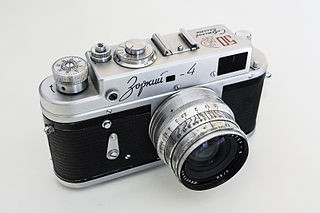
A single-lens reflex camera (SLR) is a camera that typically uses a mirror and prism system that permits the photographer to view through the lens and see exactly what will be captured. With twin lens reflex and rangefinder cameras, the viewed image could be significantly different from the final image. When the shutter button is pressed on most SLRs, the mirror flips out of the light path, allowing light to pass through to the light receptor and the image to be captured.

A rangefinder camera is a camera fitted with a rangefinder, typically a split-image rangefinder: a range-finding focusing mechanism allowing the photographer to measure the subject distance and take photographs that are in sharp focus. Most varieties of rangefinder show two images of the same subject, one of which moves when a calibrated wheel is turned; when the two images coincide and fuse into one, the distance can be read off the wheel. Older, non-coupled rangefinder cameras display the focusing distance and require the photographer to transfer the value to the lens focus ring; cameras without built-in rangefinders could have an external rangefinder fitted into the accessory shoe. Earlier cameras of this type had separate viewfinder and rangefinder windows; later the rangefinder was incorporated into the viewfinder. More modern designs have rangefinders coupled to the focusing mechanism so that the lens is focused correctly when the rangefinder images fuse; compare with the focusing screen in non-autofocus SLRs.

135 film, more popularly referred to as 35 mm film or 35 mm, is a format of photographic film used for still photography. It is a film with a film gauge of 35 mm (1.4 in) loaded into a standardized type of magazine – also referred to as a cassette or cartridge – for use in 135 film cameras. The engineering standard for this film is controlled by ISO 1007 titled '135-size film and magazine'.

The Instamatic is a series of inexpensive, easy-to-load 126 and 110 cameras made by Kodak beginning in 1963. The Instamatic was immensely successful, introducing a generation to low-cost photography and spawning numerous imitators.

Minolta Co., Ltd. was a Japanese manufacturer of cameras, camera accessories, photocopiers, fax machines, and laser printers. Minolta Co., Ltd., which is also known simply as Minolta, was founded in Osaka, Japan, in 1928 as Nichi-Doku Shashinki Shōten. It made the first integrated autofocus 35 mm SLR camera system. In 1931, the company adopted its final name, an acronym for "Mechanism, Instruments, Optics, and Lenses by Tashima".

Cosina Co., Ltd. is a manufacturer of high-end optical glass, optical precision equipment, cameras, video and electronic related equipment, based in Nakano, Nagano Prefecture, Japan.

A digital single-lens reflex camera is a digital camera that combines the optics and the mechanisms of a single-lens reflex camera with a digital imaging sensor.

The Canon A-1 is an advanced-level single-lens reflex (SLR) 35 mm film camera for use with interchangeable lenses. It was manufactured by Canon Camera K. K. in Japan from April 1978 to 1985. It employs a horizontal cloth-curtain focal-plane shutter with a speed range of 30 to 1/1000 second plus bulb and flash synchronization speed of 1/60 second. It has dimensions of 92 millimetres (3.6 in) height, 141 millimetres (5.6 in) width, 48 millimetres (1.9 in) depth and 620 grams (22 oz) weight. Unlike most SLRs of the time, it was available in only one color; all black. The introductory US list price for the body plus Canon FD 50 mm f/1.4 SSC lens was $625; the camera body was generally sold with a 30–40% discount.

The Canon AE-1 is a 35 mm single-lens reflex (SLR) film camera for use with interchangeable lenses. It was manufactured by Canon Camera K. K. in Japan from April 1976 to 1984. It uses an electronically controlled, electromagnet horizontal cloth focal plane shutter, with a speed range of 2 to 1/1000 second plus Bulb and flash X-sync of 1/60 second. The camera body is 87 mm tall, 141 mm wide, and 48 mm deep; it weighs 590 g. Most are black with chrome trim, but some are all black.

The Canonflex is a Canon 35 mm film single-lens reflex (SLR) camera introduced in May 1959. Its standard lens is the Canon Camera Co. Super-Canomatic R 50mm lens f/1.8. The camera was in production for one year before it was replaced by the Canonflex R2000, adding a 1/2000 sec. shutter speed.

The Canon EOS RT is a 35mm single-lens reflex camera produced by Canon and sold from 1989 to 1992. The camera is essentially an EOS 630/EOS 600 with a pellicle mirror. Only 25,000 were manufactured at the end of the EOS 630 production run, so the EOS RT was technically "out of production" before it ever went on sale.

The M39 lens mount is a screw thread mounting system for attaching lenses to 35 mm cameras, primarily rangefinder (RF) Leicas. It is also the most common mount for Photographic enlarger lenses.

The Canon 7 was a focal-plane shutter rangefinder system camera with an integrated selenium light meter introduced by Canon Inc. in September 1961, the last model compatible with the Leica M39 lens mount. Later versions, branded Canon 7s and Canon 7s Type II, had a cadmium sulfide light meter.

The Canon rangefinders of the late 1940s and early 1950s are Leica-compatible screw-mount cameras. Many were brought to the U.S. by servicemen who bought them while visiting Japan during the Korean War. Typically these were mounted with a 50mm Serenar lens.

The Bessa family of cameras was manufactured in Japan by Cosina as a revival of the Voigtländer brand name.

The Zorki 4 was possibly the most popular of all Zorki cameras, with 1,715,677 cameras made by the KMZ factory in Krasnogorsk, Russia. The Zorki 4 was also the first of the Zorki cameras to be exported in large numbers to the west. It is a fully manual camera, and does not have a lightmeter. An additional lightmeter may be added by the cold shoe.

The D5000 is a 12.3-megapixel DX-format DSLR Nikon F-mount camera, announced by Nikon on 14 April 2009. The D5000 has many features in common with the D90. It features a 2.7-inch 230,000-dot resolution tilt-and-swivel LCD monitor, live view, ISO 200–3200, 3D tracking Multi-CAM1000 11-point AF system, active D-Lighting system and automatic correction of lateral chromatic aberration. The D5000 seems to have been discontinued in November 2010.

The Leica copies originate from the Leica camera that was launched by Ernst Leitz, Wetzlar in 1925, using the Leica 39mm screw mount of 26 threads per inch, and the standard 35mm film. The design was carried out by Oskar Barnack, beginning in 1913 by building a camera for 24×36 mm negatives that by now is called the Ur-Leica; but Ernst Leitz did not decide to manufacture it until 1924. Once started, the Leica production volume doubled each year; in 1929, some 16.000 cameras were produced. In 1930, an improved model with interchangeable lens was introduced, followed a year later by the fully developed Leica II with standardized film to lens flange distance, and in 1932 the basic Leica Standard; the Leica concept was established. This camera's features are the basis for defining a Leica copy.

The Canon A35F is a 35mm rangefinder camera produced by Canon in 1978. It was one of the last manual-focus rangefinder cameras produced by Canon, based around the Canon Canonet 28 body. It has program auto-exposure, controlled by a CdS meter between EV9 and 17 at ISO 100. It has a built-in automatic flash with Guide No. 12 ; there is no terminal to connect an external one. The flash system is called "CATS" which meters the correct exposure according to the distance of the subject and charged voltage. The A35F - stands for "Automatic (exposure) Flash. and the newer model AF35 - stands for "AutoFocus".



















